Manual contract management takes hours and is prone to human errors that can cost an organization thousands of dollars. Issues with document tracking and handling are especially common for large organizations that process a huge number of contracts. Deploying contract management software (CMS) helps organizations reduce processing time to minutes and eliminate human error in reading the fine print, assessing risks, and managing the contract lifecycle.
That’s why the market for contract management solutions is steadily growing, both in terms of the number of players and in terms of revenue. In this article, you’ll learn what contract management software does, how to start building one, and which features end users are most interested in.
This article will be useful to leaders of development teams and companies that are considering developing a contract management system and are looking for a place to start.
What is contract management software?
Contract management is a complex, multi-stage process, and contract management software helps businesses orchestrate the entire document lifecycle. Contract management software facilitates everything from storing documents in one place to analyzing, negotiating, and signing contracts electronically.
Such software is indispensable for midsize and large organizations that have to manage tons of documents and can’t afford errors. Organizations get the following benefits of contract management software:
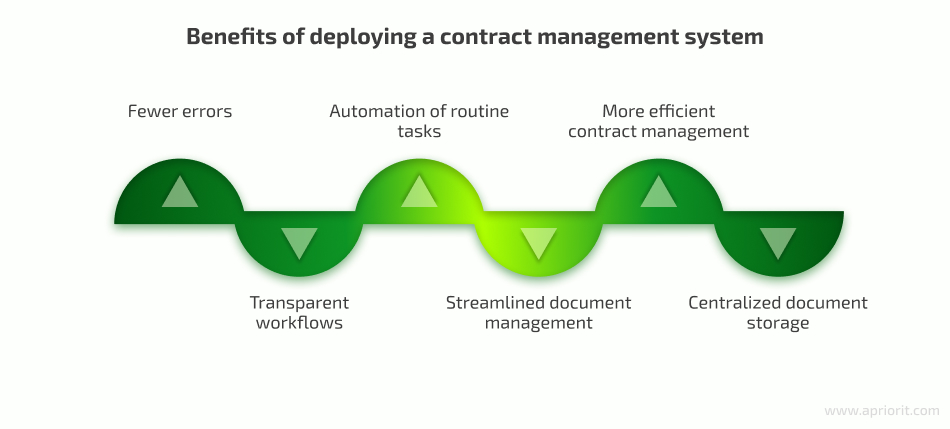
Because of the high demand for such solutions, the CMS market is growing steadily both in value and in the number of solutions on offer.
According to Future Market Insights, in 2021, the global market for contract management software was valued at $2 billion. With expected CAGR of 12.5%, it’s anticipated to grow to $5 billion by 2032. Others predict even sharper growth to $5.6 billion by 2030.
The success of a new solution in such a competitive market depends on whether it can satisfy the needs of end users. Let’s now talk about the core features that users want to see.
Plan on developing a SaaS-based CMS?
At Apriorit, we have both knowledge and real-life experience in building various SaaS-based corporate systems. Reach out to see how we can help you bring your dream product to life!
What are the key features of contract management software?
While each contract management system is adjusted to the needs of its target audience, such solutions share some core features for document management, collaboration, cybersecurity, and ease of use.
Let’s briefly overview these feature sets:
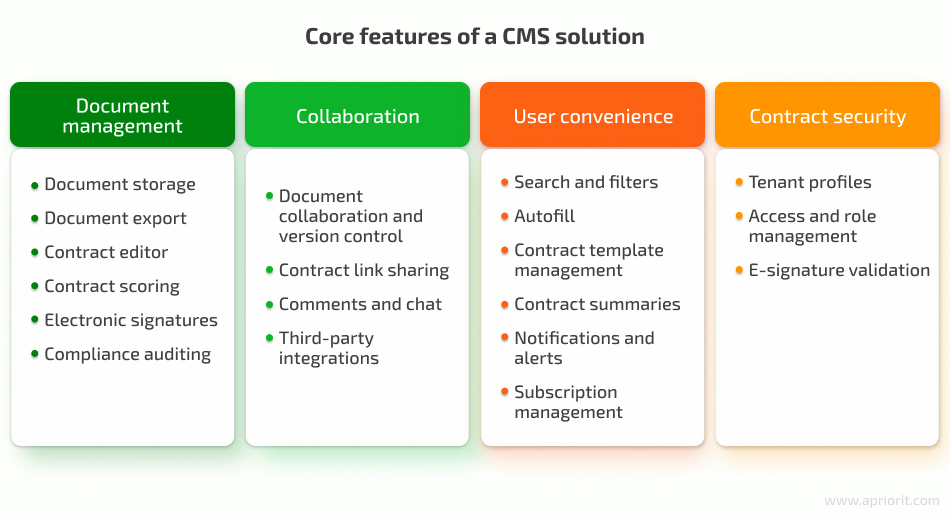
Document management
These features are essential to a CMS, allowing users to store, manage, and share their contracts. Here are the features usually included:
- Document storage. A CMS should be able to store all documents in a database hosted in a cloud or on-premises storage.
- Document export. End users should be able to download their documents in the most popular formats such as DOCX, PDF, and TXT.
- Contract editor. Allow your users and their business partners with appropriate access levels to edit documents inside the CMS, preserving the history of edits.
- Contract scoring. Implement rule-based or artificial intelligence (AI) algorithms to identify problematic clauses in a deal that may be risky for your end users and calculate the overall contract health score based on compliance with specific business terms.
- Electronic signatures. E-signature is a core feature of any CMS that allows users to sign documents securely and quickly. You can implement e-signature functionality by developing your own functionality or by integrating a third-party service.
- Compliance auditing. Allow your users to automatically check if their contracts comply with certain regulatory and legal requirements.
Collaboration
Many users have to interact with a contract during its lifecycle, so you need to ensure that your end users can work on documents together and share them conveniently. The key features of contract management software to ensure such teamwork are:
- Document collaboration and version control. In order to avoid the mess of different document versions being saved in different places, your users and their business partners should be able to collaborate on documents in one place and always have access to the change history.
- Contract link sharing. A CMS should be convenient to use even for those not registered on your platform, such as your users’ business partners. Link sharing allows users to send documents to their partners and collaborate online.
- Comments and chat. Facilitate the negotiation process by adding the ability to comment on documents and chat about them without leaving your CMS and without scattered email correspondence.
- Third-party integrations. Help users adopt your CMS into their existing business ecosystem. You can integrate your solution with Microsoft, SalesForce, Google, and other companies depending on what your target audience uses in their business processes. Also, consider integrating payment processing services to help your users pay for subscriptions and transfer funds.
User convenience
Ease of document editing and management is one of the key selling points for contract management software. It should help users automate simple work with documentation, speed up processes, and free some of their time. Here’s how you can ensure convenient document management within your CMS:
- Search and filters. Users want robust search functionality to find exactly what they need in seconds. You can also implement filters that allow users to sort documents by parameters like date of creation.
- Autofill. Autofilling information in common fields like company name, address, and contact and payment information can accelerate the contracting process. It also reduces the number of errors in contracts since users don’t have to add this information manually (and repeatedly).
- Contract template management. Templates save users’ time when creating contracts. Templates should have flexible layouts and variables, as well as drag-and-drop editing functionality.
- Contract summaries. This feature highlights the most important parts of a contract, hidden risks, and costs, as well as previous contract terms for a given partner. It helps users quickly revise and assess contracts.
- Notifications and alerts. Notify your users of deadlines, deal milestones, contract changes during negotiations, and more.
- Subscription management. If your CMS is offered as a subscription, users should be able to review and manage their subscriptions directly in the software.
Read also
How to Create a Reliable SaaS Accounting Solution: Core Characteristics, Architectural Components, and Features
Discover the core characteristics, must-have features, and architectural components of a SaaS-based corporate accounting solution.

Contract security
A CMS stores a lot of sensitive information about an organization, both in contracts and user data. You can protect such information by adding the following features:
- Tenant profiles. If you’re building a SaaS solution that will be used by many companies, users should be able to create company profiles in your system and manage their content and settings. You can make this happen by implementing a multi-tenant database model.
- Access and role management. An organization should be able to reflect its structure in the CMS by assigning different roles and access levels for documents to their employees and business partners.
- E-signature validation. Users need to pass authentication every time they electronically sign a document to prevent identity fraud and errors. This can be done either through a phone number or biometrics.
This feature set is a must for contract management software, but you can add more features to cater to your audience’s needs. Now, let’s take a look at the key steps of developing secure, performant, and customizable contract management software.
How to build contract management software
Diligently preparing to develop a SaaS-based solution only gets you halfway to success. For example, the architecture of your solution will influence its ability to scale and adapt after the release. Cybersecurity measures you choose to implement may attract or push away organizations that work with sensitive information.
Here are the key steps to developing a reliable and competitive CMS:
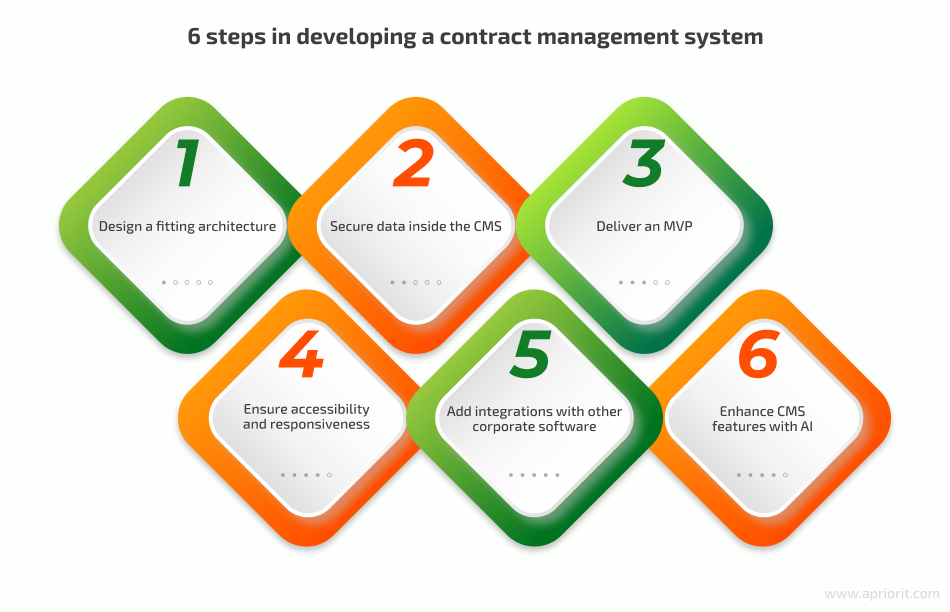
1. Design a fitting architecture
The architecture is the foundation of any SaaS-based solution that establishes how it will work, which cloud services and resources it will rely on, and how it can change in the future. When your solution is deployed, changes to its architecture can require a lot of rework or even the start of a new development process. That’s why it’s best you pay attention to the architecture before any code is written.
Key aspects to consider when designing an architecture are:
- Compliance with business goals and objectives
- Use of a monolithic or microservices approach
- Support for single- or multi-tenancy
- Targeted performance and scalability options
- Cost-effectiveness of chosen cloud resources
2. Secure data inside the CMS
Any CMS gathers and stores loads of sensitive information: intellectual property, NDA-protected data, financial details, personal information of end users, etc. Ensuring the protection of this information allows you to both make users trust your solution and comply with various cybersecurity contract management software requirements like the GDPR, PCI DSS, and ISO 27001.
The core cybersecurity mechanisms you can implement include:
- Role-based access control, which allows administrators to assign each user within their organization a role and a corresponding set of access rights. This way, users will be able to view only the information that they need for work.
- Identity management that helps a CMS verify the identities of users before providing them access to sensitive files. This feature makes it hard for malicious actors to hack user accounts.
- Data encryption at rest and in transit. Encrypting records helps to ensure that only users with corresponding access rights can interact with them and that records will stay safe even if they get into the wrong hands.
- Logging of any actions with sensitive information. Logs help administrators and third-party auditors review suspicious activity and investigate cases of data theft, corruption, and leaks.
Make sure to research common threats your target audience can face and the contract management software features they need to protect their information.
Read also
Comparison of Identity and Access Management Services: Building an On-Premises Solution vs a Cloud-Hosted Solution
Discover how to design, develop, and implement identity and access management into your solution!

3. Deliver an MVP
A minimum viable product, or MVP, is a version of a product with basic functionality that gets across your business idea and provides value to end users. Developing an MVP before a finished product helps your business test its ideas with end users, gather early feedback, and make adjustments accordingly. This way, you increase your chance of commercial success with the final product.
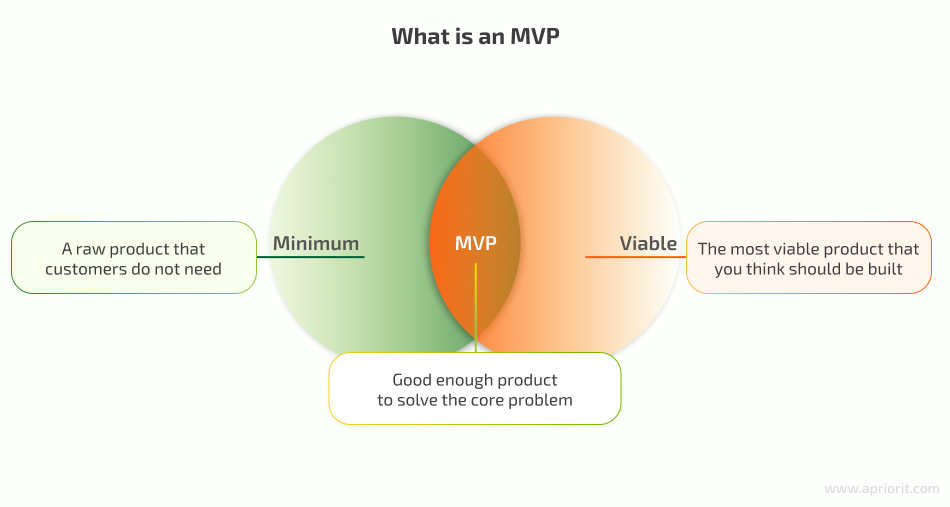
When working on an MVP, make sure to:
- Clearly define which features form the core of your contract management software and which can be implemented later in the full version
- Use ready and open-source solutions to reduce the cost of rework
- Focus on performance and reliability
- Design the MVP so you can use it as the basis for development of the full solution
- Automate the gathering and processing of user feedback
4. Ensure inclusivity and responsiveness of your solution
One of the key advantages of delivering a CMS as a SaaS product is providing end users with the opportunity to work with your solution from any place and device. Corporate users who often go on business trips and use laptops and smartphones for work especially value this flexibility.
But to be able to provide quality services for a variety of users on different devices, you need to make sure that your CMS is inclusive and responsive.
Inclusivity makes your application accessible to a variety of users with permanent or temporary limitations. For example, implementing reading adjustments like configurable font type and size, contrast, and spacing between lines helps users with vision impairment easily read contracts or simply use your software on a device with a small screen.
Responsive design makes a contract management software convenient to use on any device by adapting it to the device it’s displayed on. Usually, this requires creating several page layouts and implementing responsive properties that will adjust a layout to a particular screen size.
5. Integrate with other corporate software
Midsize and large organizations often use a suite of corporate software for various business spheres: human resource management, accounting, project management, customer relationships, IT, etc. Adding new solutions on top of existing ones is a huge challenge for system administrators, so a CMS with a variety of out-of-the-box integration capabilities will have an advantage.
To discover which integrations your solution needs, you can:
- Analyze available APIs of competitors’ software
- Interview your end users to find out which solutions they use
- Research the most popular corporate applications
You can gain extra points by adding APIs not only for professional software but for common quality-of-life services as well. These can include secure cloud file sharing, email hosting, office software, etc.
6. Enhance CMS features with AI
AI can bring a lot of contract management software features to a new level by providing end users with intelligent automation, content analysis, and insights into contracts. For example, AI can enhance:
- Data extraction from documents
- Review of contract terms and clauses
- Compliance review
- Detection of fraud and suspicious clauses
- Risk scoring for each contract
To implement these features, you can rely on natural language processing, optical character recognition, and semantic analytics. There are a lot of third-party solutions based on these technologies, so you can integrate some of them into your CMS. Another option is to develop custom AI functionality that fits your users’ needs.
Note that using AI for legal purposes like writing or automatically signing contracts may lead to legal consequences for your users, as AI models can make mistakes. That’s why you need to notify your users if AI does any content generation or decision-making in your CMS and advise them to double-check the AI’s output.
How Apriorit can help you with contract management software development
Apriorit has experience building many types of corporate SaaS solutions, including for accounting, HR, project, and contract management. We understand why is contract management software important and know the best development practices and tech stack for such projects. On top of that, we can provide our clients with expert business analysis, project management, and quality assurance to help them deliver a truly competitive solution within their deadlines.
During one of our CMS development projects, the Apriorit team delivered a comprehensive tool for managing contracting processes, assigning a risk value to each term and scoring the overall health of each contract. Our client, Contracts Rx, came to us with a vision of a product for document risk scoring, and we helped them turn this vision into a competitive SaaS platform with several contract-related services.
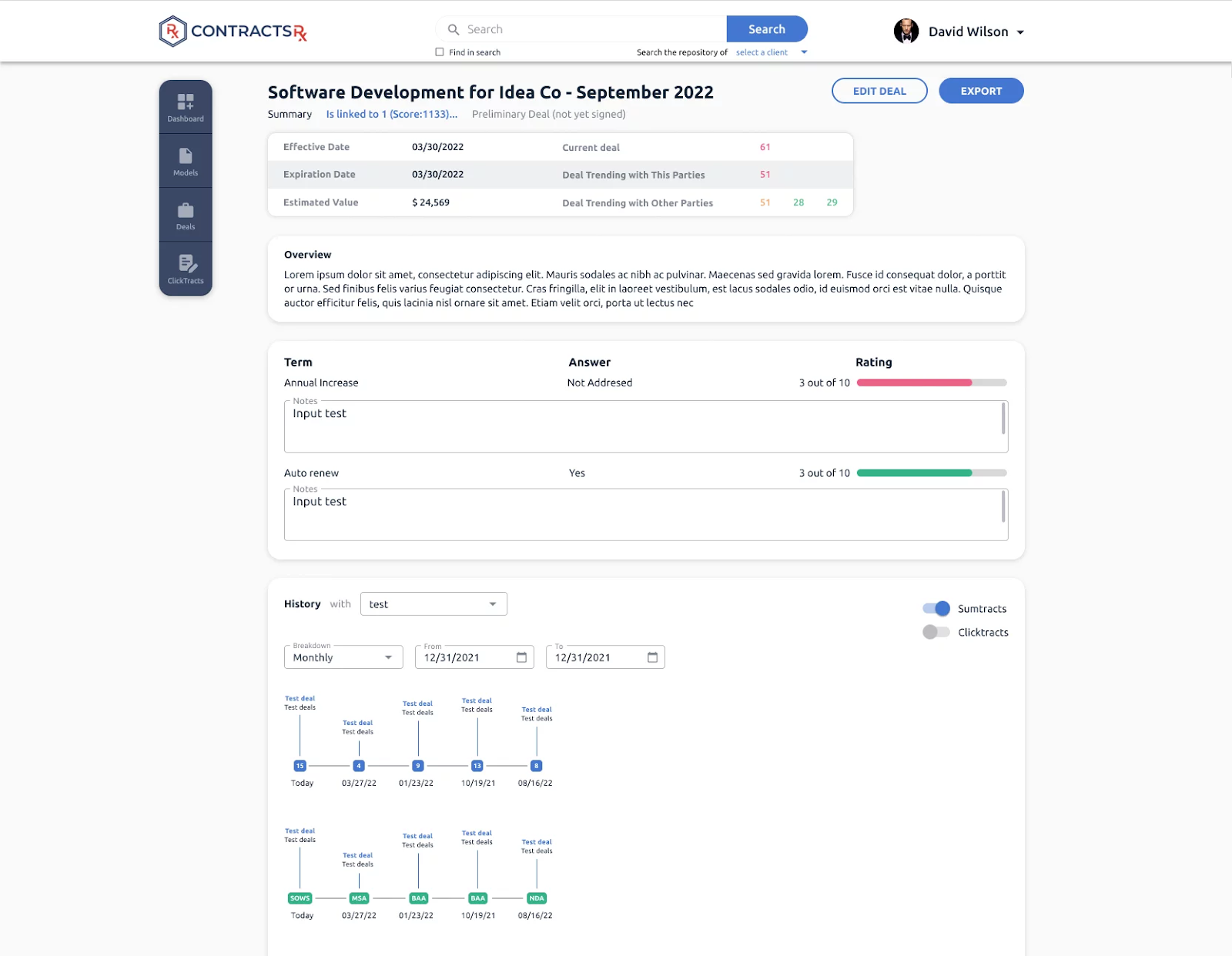
As our client had no web development expertise, they requested a dedicated team that included an Apriorit business analyst, a project manager, a designer, developers, and QA specialists. We helped the client form their vision of the product and deliver it to the market. As of now, over 300 companies use this solution as their primary contract management platform, and the number of users is growing rapidly.
When building any SaaS solution, we take into account the client’s requirements, results of business analysis, and industry requirements. We also pay attention to the solution’s performance, security, and maintainability. This attention to a variety of development aspects helps us to develop successful solutions that fit our clients’ needs.
Conclusion
Contract management software is getting more popular with midsize and large businesses, and the demand for CMS solutions makes it challenging to deliver a system that can compete in a rapidly developing market. To make a successful contract management software for business, you have to satisfy end users’ needs in terms of available features, ease of use, security requirements, and the ability to integrate with other software.
In this article, we overviewed the must-have features of a contract management system and key steps to develop one. However, building a competitive SaaS-based CMS that will attract end users is far more nuanced.
Our SaaS development team has real-life experience delivering various cloud-based corporate solutions that help our clients become confident players in their target markets.
Have an idea for a SaaS solution?
Reach out to discuss your project vision and how we can help you turn it into a competitive product!


